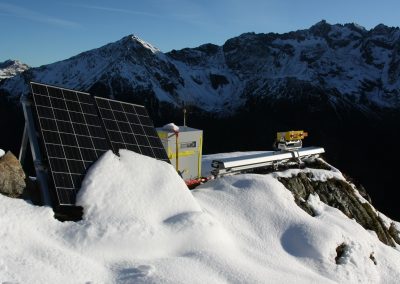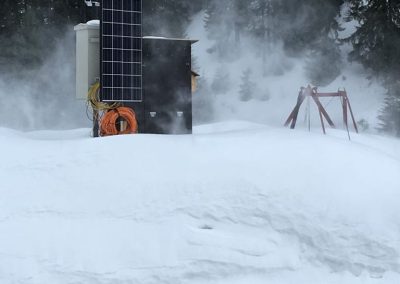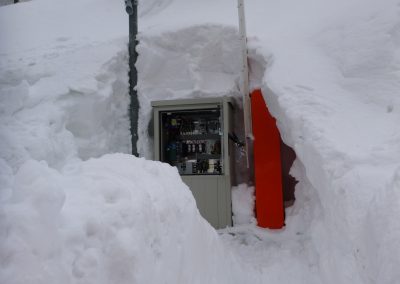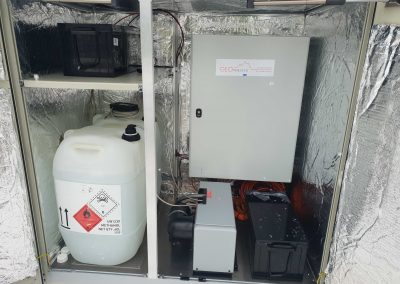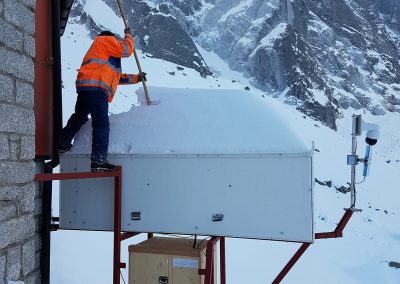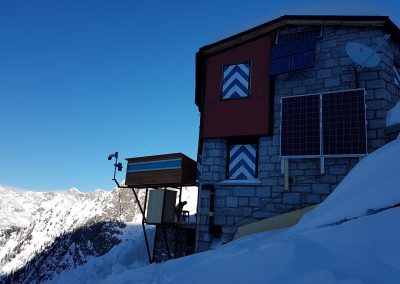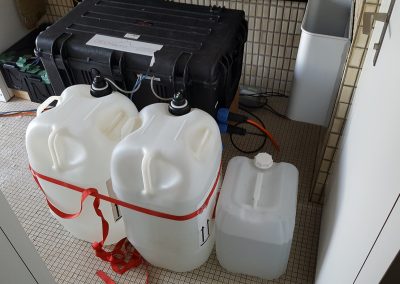Power supply at freezing temperatures and in deep snow
Our alarm and monitoring system are frequently located in very remote areas from where they observe avalanche slopes, unstable rock faces, glacial lakes or other areas at risk of natural hazards. System operation requires power for measurement instruments and cameras as well as data logging and transmission. How to guarantee uninterrupted power supply for stations with difficult access all year round? In addition, these stations are exposed to rough weather conditions; for mountain stations these are low temperatures, snow, ice and wind.
If no mains electricity is available, several alternative energy sources exist to supply a monitoring or alarm station. However, the energy demand of a certain station depends on the applied measurement technology and the associated sensors. We mostly use solar panels and/or a fuel cell for reliable energy supply. Solar cells are self-sufficient, handy and cost-efficient – but they may require sun where there isn’t any. Some stations receive little or no direct sun light during the winter months due to the low position of the sun (e.g. above the polar circle or in the shade of a mountain). In some cases, the amount of sunlight reflected from the opposite slope is sufficient or a large battery can bridge the dark winter time. Yet, stations with higher energy demand are reliant upon a different or a second energy source.

Polar night in northern Norway (69° North) where our avalanche radar is installed at the bay of Holmbuktura.
In this case, methanol fuel cells are commonly deployed as alternative (or additional) energy source. Fuel cells are very reliable electricity suppliers and run in any weather – as long as fuel is available. For this reason, methanol tank dimensions are usually chosen in order to last a full year.
Radar at Pizzo Cengalo in the sun again
Depending on the station location, it may make sense to combine multiple energy sources; for example the georadar monitoring station at Pizzo Cengalo which is supplied by solar panels and a methanol fuel cell. Whereas the fuel cell provides most of the required energy during the winter months of low-sunlight, the solar panels contribute their share as soon as the sun reaches above Pizzo Cengalo.

Service data of the georadar monitoring station at Pizzo Cengalo/Bondo: The solar cell battery voltage reflects the station’s sunny periods that are getting more and longer day by day now. If the solar energy gets low, the fuel cell kicks in and takes over the supply. Station service also includes monitoring of the (mobile) radio frequency level.
Other possible (location-dependent) power sources are wind or water turbines. Further, all our stations have generously dimensioned batteries to bridge a power supply failure. The battery size mainly depends on the type of monitoring system (e.g. alarm system), the applied measurement technology as well as the geographical setting. Batteries are an additional buffer and enable intelligent energy management. All service data, e.g. battery voltage or filling level of the methanol tank, are continuously and automatically checked by us as part of our service packages. The service data can also be viewed online via the online data portal. In this way, we are able to identify potential problems at an early stage, and hence guarantee uninterrupted power supply to even our most remote stations.


